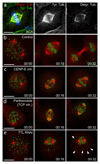The Tubulin Code: A Navigation System for Chromosomes during Mitosis
- PMID: 27344407
- PMCID: PMC6398581
- DOI: 10.1016/j.tcb.2016.06.001
The Tubulin Code: A Navigation System for Chromosomes during Mitosis
Abstract
Before chromosomes segregate during mitosis in metazoans, they align at the cell equator by a process known as chromosome congression. This is in part mediated by the coordinated activities of kinetochore motors with opposite directional preferences that transport peripheral chromosomes along distinct spindle microtubule populations. Because spindle microtubules are all made from the same α/β-tubulin heterodimers, a critical longstanding question has been how chromosomes are guided to specific locations during mitosis. This implies the existence of spatial cues/signals on specific spindle microtubules that are read by kinetochore motors on chromosomes and ultimately indicate the way towards the equator. Here, we discuss the emerging concept that tubulin post-translational modifications (PTMs), as part of the so-called tubulin code, work as a navigation system for kinetochore-based chromosome motility during early mitosis.
Keywords: CENP-E; Dynein; detyrosination; motors; post-translational modifications; tubulin code.
Copyright © 2016 Elsevier Ltd. All rights reserved.
Figures



References
-
- Antonio C, Ferby I, Wilhelm H, Jones M, Karsenti E, Nebreda AR, Vernos I. Xkid, a chromokinesin required for chromosome alignment on the metaphase plate. Cell. 2000;102:425–435. - PubMed
-
- Auckland P, McAinsh AD. Building an integrated model of chromosome congression. J Cell Sci. 2015;128:3363–3374. - PubMed
-
- Barisic M, Aguiar P, Geley S, Maiato H. Kinetochore motors drive congression of peripheral polar chromosomes by overcoming random arm-ejection forces. Nat Cell Biol. 2014;16:1249–1256. - PubMed
Publication types
MeSH terms
Substances
LinkOut - more resources
Full Text Sources
Other Literature Sources
Molecular Biology Databases
Miscellaneous

